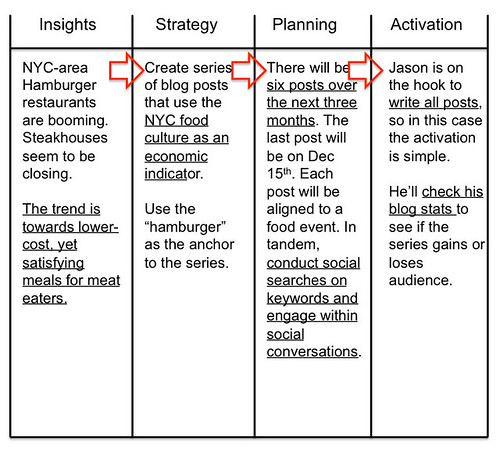Applied Cultural Economics “Map”
When I produce my Applied Cultural Economics work, I use a set of tools to help determine what tasks I need to focus on. One tool I use frequently is the below “map.” This tool allows me to identify where a client’s efforts reside on the map and what steps I need to take to help them be successful.
Below, through a few “white-board” drawings, I’ll illustrate the flow of impact through the map. Each circle represents a role, a behavior of a person or organization that creates and has influence on the impact. Simply, impact moves from left to right.

In an ideal Cultural Economics flow, the impact starts all the way at the left and flows all the way to the right. To keep it simple, I label the “thing” that needs to be guided across the map a “spark,” but in most cases a spark is a piece of creative content. These sparks could originate throughout the flow, and there are unique strategies to ensure these sparks create impact based on where they originate. In the ideal, these sparks originate at the “Trailblazer” layer as this allows the spark to be infused with the most momentum as it travels across the map. The spark can catch a fire, be homogenized, or it can fizzle out quickly.
Here’s a quick breakdown of the roles labeled in the map (these roles are updated from an earlier post I did on this topic found here):
Trailblazers: These are the fiercely innovative individuals and organizations who are inventing the next “thing.” Their greatest concerns are for newness and innovation. They are the artists of their specific disciplines, the cutting-edge. They aim to bring new ideas (or new combinations of ideas) into the world.
Futurists: These are the discoverers of the cutting-edge who eagerly seek to share their findings with their audiences. The result/rewards of this sharing is more about social capital and the value of their sharing than financial. Their goal is to gather their findings into insightful, thought-leadership bundles before anyone else does. They amplify and provide trajectory to the life of the spark, often modifying the initial spark to map to their own agenda.
Pundits: This group sifts through the happenings of the Futurists to identify which sparks would resonate with their audiences. The pundits work to reconfigure the sparks within their own brand for personal or organizational gain. They are reliant on the futurists to do the initial filtering, but take it the step further to create ingestible, adoptable packets of information for their markets and audiences. The Pundits layer is where a spark can become a revenue driver.
Think-Sharers: This is currently the most active group on the map and where a spark can gain the most boost. Think-Sharers are the new “word-of-mouth” layer now with greater strength through the power of social media. People who play this role are actively sifting through the “firehose” of social data (news, links, thoughts) and sharing and/or re-sharing the sparks that resonate most with them and potentially with their audiences. Think-sharers are also powered by social-capital (like the Futurist) versus financial gains. Think-Sharers are seeking to gain recognition by the sparks they share.
Consumers: This is the largest, yet passive layer. This is the dense-middle that sparks have to traverse to remain relevant. Consumers are typically the last stop for a spark as they are ones who consume it, typically for pleasure, leisure, or intelligence. In many cases the initial spark has been corrupted/assimilated from its original form in order to become adopted by consumers. In unique, and potentially ideal, cases the initial spark remains mostly intact.
Late Adopters: If a spark is successfully consumed, there will be a group of late adopters who will eventually consume the spark as well. In some cases these Late Adopters can breath new life into a spark, like a reverb effect.
Lurkers: This layer is the very last stop for a spark. The most passive of all roles the lurker chooses to engage with the spark after its greatest relevance has passed.
Let’s walk through a spark scenario. I’ll use the metaphor of a “rock band” to guide us through the flow.
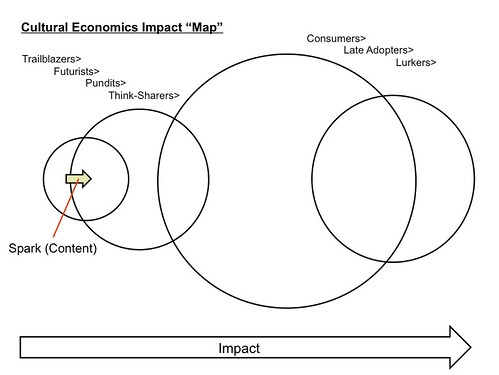
Four friends have a spark, they decide they want to start a band, write new songs, and change the world. The spark is driven by their passion to make music. Making money would be cool, but that’s not the driver for their decision.They write songs, rehearse them, post mp3s online and gain some gigs at local clubs. They share their spark with their immediate world. They are the Trailblazers.
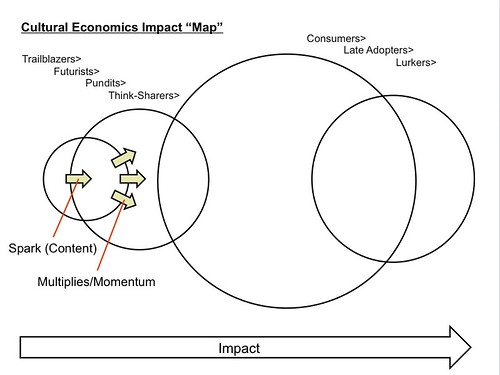
Then, a local music blogger searching the listings for local clubs sees the name of this new band. She searches for them online and finds their sample mp3s. She listens to them and writes up a blurb about their sound and recommends people go to the show. Another music fan also happens upon the listings, finds the mp3, and shares it with her twitter list and facebook friends. A good friend of the band also shares the mp3s with his coworkers to showcase the “cool new band” he found. They all go to the show and share their experience of seeing the band with their followers (checkins, tweets, updates, blog posts). These Futurists are multiplying the instances of the spark, giving it momentum, while also adding their own unique layer to the spark.
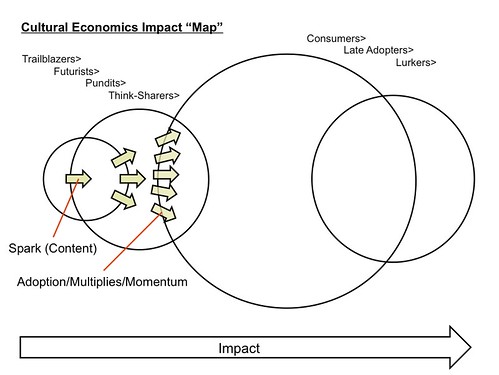
Through the activity of the three Futurists, a growing number of people are hearing about the band and listening to their songs and going to the gigs. The Pundits are now interested in the activity. More established music bloggers, a local alt-weekly music critic, and a few folks with large social followings start going to the shows. The Pundits write their reviews and share the music with their audiences. They’ve added new layers to the spark, such as wider context of the music, it’s relationships to other bands, where they predict the band (and it’s spark) will go (which audiences will like it). This context might corrupt the original spark, but now the spark has momentum and new audiences.
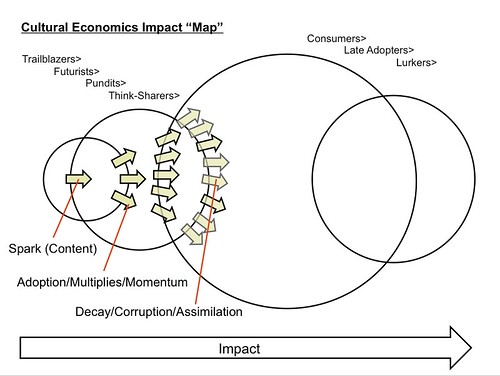
If the Pundits have done their role well, the spark has now been heard by a widening audience of music fans. This next layer of fans, the Think-Sharers, will compound this amplification by sharing the links to Pundits’s reviews with their audiences via tweets, checkins and status updates. If all goes well, the spark will remain intact and the band’s music will continue its momentum into finding a wider audience. If all doesn’t go well, the Think-Sharers either don’t share what the Pundits have posted, or they share the links with muted interest. As example, they compare the band to less favorable bands or only give the band a simple, passionless mention. The spark then decays and loses momentum.
This is a highly sensitive and important aspect to the flow…the Think-Sharers have tremendous impact on the momentum of the spark into the realm of the passive Consumers. If the spark doesn’t resonate with the Think-Sharers the odds the the spark will decay increases. This could be caused by which Pundits found the spark initially and/or how they wrote about the spark…which is impacted by the Futurists who spotted the spark. One layer impacts the next. If the “wrong” Futurist finds the spark, and the “wrong” Pundit writes about the spark, the spark might never get the chance it deserved.

If the spark is strong, and has found the right advocates in Futurists, Pundits and Think-Sharers, it will reach through the entire map. This is the goal of any spark. This is the focus of Applied Cultural Economists; to help sparks navigate their way across the map. The map is one tool towards this end, I rely on it all the time.
They key steps to use this map is to determine where on the map the spark is and then to identify which roles need to be mobilized to add momentum to the spark. I’ve created a PDF version of a blank map for you to download if you want to give it a try: http://jasn.it/QsqSlw.

